With the San Jose Sharks a week away from their Oct. 3 season opener, we continue our season preview. We’ve covered the team’s pre-Erik Karlsson trade roster, our expectations for the division opponents, the Sharks’ area of greatest vulnerability and the team’s X-factors. I’ve taken a look at important side effects of the Karlsson trade, and my colleague, Mac Bass, offered his take on the deal as well. We’re onto the second article on key statistics for Sharks head coach Peter DeBoer to consider. The first covered important goalie results and how they relate to a Stanley Cup winners.
There are a lot of statistics one can use to describe Joe Thornton, the best and most important player ever to don a San Jose Sharks teal jersey. He is nearing the end of a Hall-of-Fame career, but he is by no means done. A healthy season and he’ll pass legends on all-time lists including Mario Lemieux, Marcel Dionne and Gordie Howe.

One question the Sharks need to answer is: how best to use the 39-year-old Thornton? The responsibility falls to Sharks head coach Peter DeBoer and he needs to get the answer right. I’ll cite a series of different statistics which will help.
Thornton’s Most Critical Stat
The first statistic is the most important of all. Thornton tore knee ligaments in the 79th game of the 2016-17 season. It was also the third game in four nights. Athletes, especially older ones, are more vulnerable to injury as they age. There are a variety of reasons, but one is this – many injuries are prevented by reflex. Reflexes sense danger and react in far less than the blink of an eye. Tired and fatigued muscles are a bit slower to react. So are the muscles of older players. The game Thornton was injured in 2017 is the exact sort of game he’s most vulnerable.
It might not come as a surprise when I note Thornton tore ligaments in his other knee, once again, playing a third game in four nights. Both times, it was also a fourth game in six nights. On the 2018 injury, Thornton had a lot of ice time, over 76 minutes in total, in those four games. At the time of injury, he’d already exceeded 20 minutes of ice time in that particular game. On the 2017 injury, he’d played over 60 minutes in the prior three games. In both cases, the injury occurred at a time of great vulnerability.
In looking at the plays around both injuries, they weren’t particularly unusual hockey plays, just ones with unfortunate outcomes. Is it possible a less fatigued Thornton avoids injury? I’ll suggest the answer is ‘yes’. It seems probable it played a meaningful role in both. Some may go the denial route and argue there is no definitive proof (for or against). But it’d be wrong, and dangerous, to dismiss the possibility of fatigue playing a key role in these injuries.
The first key to getting the most out of Joe Thornton is to limit, or avoid, playing him in situations where fatigue can contribute to an injury. In the last four seasons, he’s averaged between 18:04 and 18:23 of ice time per game. This number should drop under 16 minutes. Instead of attempting 82 games at over 18 minutes a night, try 75 games averaging 15-16 minutes a night.
It’d be wise to have Thornton sit out one game during of these ‘four games in six-night’ sequences, given this is where the damage was done, both times. By my count, he’d miss seven games this season, a very small risk for a very important reward. If DeBoer decides against this approach, he can still significantly reduce Thornton’s minutes in each of the games in these densely-packed sequences.
Thornton’s Pluses & Minuses
The second statistic is Thornton’s plus-minus from last season. He’s been a plus-player almost his entire career, and quite often, plus a whole bunch. In 2017-18, he was minus-nine, easily a career worst. Prior to last season, he’d been a minus player only once in his last 15 seasons. At 5-on-5 last season, Thornton wasn’t great. Or even good.
Joe Pavelski is one of the best wingers in the league. He has never finished a season as a minus player in his 12 seasons. Yet he also posted a career-worst plus-minus last season. Pavelski was minus-10 while coupled with Thornton and hit a season-low minus-12 just two games later. After Thornton went down, Pavelski returned to his role as a center, his plus-minus figure started to rise, and he eventually finished the season at even by going plus-12 over the final 32 games of the season – without Thornton.
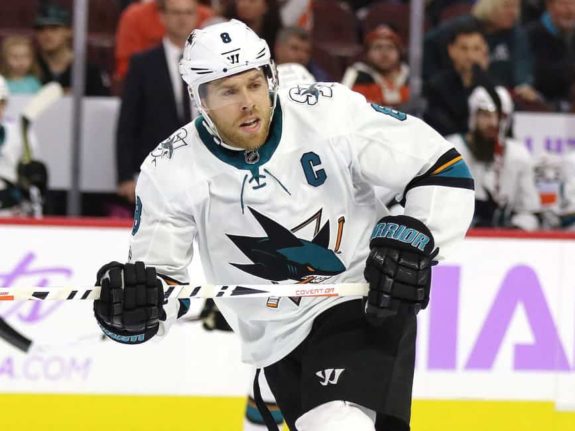
Is it accurate to say Joe Thornton is a liability at even strength? While it’s uncomfortable to suggest, it has to be considered. It’s tempting to completely dismiss the idea by suggesting last season was a result of circumstances such as Thornton attempting to return so quickly from his April 2017 knee surgery. This temptation needs to be refused. Thornton’s even strength game merits an honest evaluation.
Thornton’s Game-Changing Role
So if Thornton isn’t great at even strength anymore and he’s not used in the penalty kill, it pretty much leaves the power play. Was Thornton good in this role? In this case, ‘good’ is a severe understatement. He was exceptional – and that also might be an understatement. In his last 21 games before his injury, the Sharks scored 24 power play goals and the team went 12-4-5 in the process. Averaging a power play goal per game is 50% better than the league median and it’s been eight years since any NHL team averaged a power play goal per game over an entire season.
The Sharks were rolling at 1.14 power play goals per game, a stunning 70% above the league median. Thornton was the sauce which made the power play sizzle; it was the best power play in the league. In Thornton’s absence, the power play output dropped by over 60%, with the team netting just 15 power play goals over the final 35 games, or 0.43 power play goals per game.
An elite power play can do a lot of things to other teams, including forcing opponents to play a bit more tentatively. It’s a high leverage part of the game and having the best power play will mean a ton to this Sharks team.
The Thornton Plan
Taken as a whole, what can we do with the stats around Thornton’s injury history, his plus-minus and his power play prowess? It’s not hard to offer up a recipe. Play him less to avoid injury by giving him a game off during four games in six nights sequences. Reduce his even strength ice time and add more power play time. This reduces injury risk, lessens his time on the part of the game where he is less effective and adds more time where his is a game-changer.
My suggestion might seem a bit radical, but it makes a lot of sense. Drop Thornton to the fourth line, certainly to start the season. Obviously, he isn’t a fourth line talent, so he’ll get plenty of mismatches. And by all means, don’t have a Thornton-led fourth line play seven minutes a night. You can roll this more than a typical fourth line. A portion of the minutes taken out of his 5-on-5 time are redistributed to the power play. I’m suggesting he take extended shifts, perhaps as much as double shifts on the power play. Late last season, DeBoer used this approach with Brent Burns. If Thornton is playing fewer even-strength minutes, he’ll have more than enough juice for much longer power play shifts.
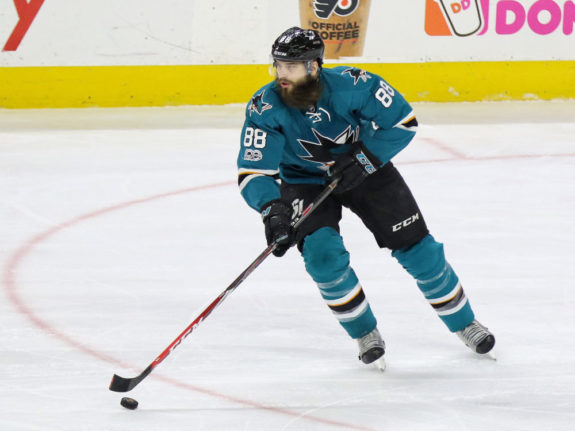
A typical game distribution of Thornton’s minutes under this approach, especially in the first few months of the season, might be 10 minutes at even strength and four minutes on the power play (the team averaged just under five minutes of power play time per game last season). In 2017-18 Thornton spent just under 20 percent of his ice time on the power play. There is good reason to push it over 25 percent this season as a result of increasing his power play ice time and decreasing his even strength ice time.
More Benefits of the Thornton Plan
There are other benefits to this approach.
With good reason, DeBoer likes keeping center-winger combinations paired together. Three center-wing pairs formed last season, two in Thornton’s absence. Center Chris Tierney paired with winger Timo Meier and center Logan Couture paired with winger Tomas Hertl. Joe Pavelski moved to center following Thornton’s injury and finished the season with Evander Kane on his wing. All three were strong pairings. With Tierney gone (traded to Ottawa), the bottom six can use some talent. By moving Thornton down, the Sharks lower lines are improved, the lineup has greater balance and the two remaining pairings which were good last season can stay intact for this season.
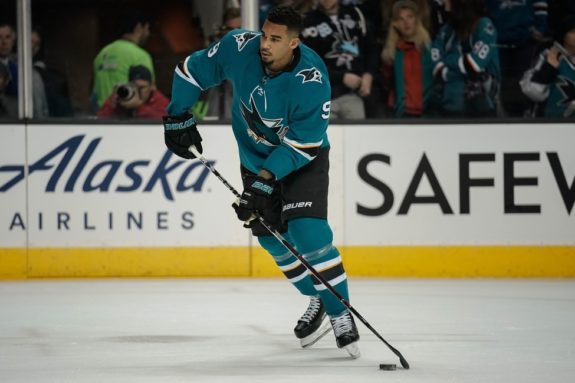
Having Thornton center the fourth line allows DeBoer to play to his team’s strength. But there is another reason and it has to do with something (I expect) general manager Doug Wilson wants to do. Wilson has not been shy about adding talent in-season. Among the talented wingers who have a better than average chance of winding up on the trading block are Wayne Simmonds of the Philadelphia Flyers and Artemi Panarin of the Columbus Blue Jackets. Either would instantly fit on Thornton’s wing, giving the Sharks another very formidable line without having to juggle any of the other lines. Plug-and-play. At the time of a trade, Thornton can increase his ice time with his new winger. The Sharks don’t have the salary cap space now to make this sort of move without moving a player. But as the season progresses, the cap space math changes and a move becomes more possible.
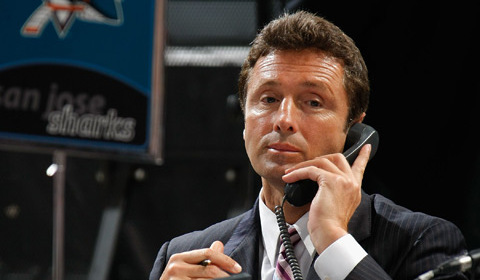
Giving Thornton a fourth line role enables a better recovery path from his past two injury-laden seasons. Too much early season stress creates risks both at the start of the season and perhaps lingering effects over the course of it. By starting the season on the fourth line, he can ramp up his play as his recovery continues. If he improves enough, simply add ice time or move up a line. He can start at 14 minutes a night and work his way up to 17 minutes in the second half of the regular season (which is one year post-injury), then take another bump if warranted for the playoffs. Where he starts the season doesn’t need to be where he ends it.
If a shiny new winger comes to San Jose and is of Panarin/Simmonds quality, the Sharks can roll a 1a, 1b, 1c line. Hertl – Couture, Pavelski – Kane, and Thornton with a new winger. The Sharks will have what amounts to three very dangerous lines, the sort of depth almost no other NHL team can match.
DeBoer’s Plan?
While Thornton is expected in the Sharks starting line-up on opening night, it doesn’t mean he’ll be anywhere close to 100% healthy. Indeed, the combination of a torn ACL and MCL probably takes between 12 and 15 months to complete the recovery. Thornton’s injury occurred in January 2018, meaning he’ll probably be as good as it’s going to get by April 2019.
The plan I’ve suggested emphasizes what Thornton does best, limits him in the area he most recently struggled and offers him the chance to gain back his health in a sensible way. Importantly, it gives him the best chance at maintaining his health over the course of the season and into the playoffs.
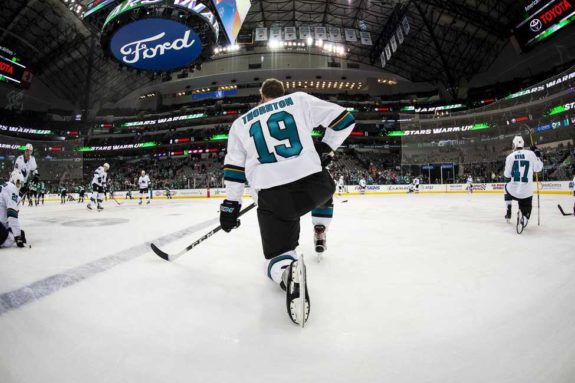
This approach isn’t the only one, but there needs to be a risk reduction mentality – which means an actual plan – to help get Thornton through this season. There is no way to bubble wrap Thornton and take risks to zero. But there are ways to lower the risks considerably. I consider this a mandatory part of DeBoer’s job. Coaches often talk about not repeating the same mistake. What happened two seasons ago also happened again last season. Both injuries came at a time when the player was most fatigued. It’s not acceptable to repeat the pattern of prior seasons and hope it’s different this time. Something must change.
Will DeBoer do this? The indications so far say ‘no’. He has Thornton with Evander Kane and Joe Pavelski in practice and in the preseason game. DeBoer has his top line and if prior seasons are any indication, he’ll give them plenty of ice time. He’s also loaded up the Logan Couture line, with wingers Timo Meier and Tomas Hertl. This means the bottom six won’t have nearly the talent level and DeBoer might need to skimp on minutes for those ‘hold your breath’ lines.
This wouldn’t be the first time DeBoer overlooked fatigue-related concerns with the Sharks. At the start of the 2016-17 season, DeBoer acknowledged potential problems resulting from a long prior season (Stanley Cup Final appearance), a shortened offseason (World Cup of Hockey) and a compressed schedule. Despite openly stating his concerns at the start of the season, he ran the 2016-17 team into the ground.
Ask DeBoer and he’ll tell you he believes in having four competitive lines. I’ll pay attention to his actions more than his words. Line balance isn’t part of the picture thus far. With only two strong lines, expect DeBoer to increase their role, which includes Thornton’s role. Which means DeBoer is probably not concerned with reducing Thornton’s injury risk.
This not the direction I’d take.
DeBoer is playing with fire if the plan is what it appears to be. I’ll grant the plan could change or there are elements DeBoer is implementing which are not yet obvious.
Thornton is important to the team on the ice, and he’s also the most important player in franchise history. He has a big public persona and a fan base which adores him. There’s a responsibility to get Thornton’s season right which goes beyond most the need of most players. DeBoer’s expected path carries much greater risk without a meaningful reward.
Zeke’s Notes
Thornton was not the only star athlete to return to action during the weekend of Sept. 22-23. Thornton made his return on Saturday night, while another player who tore his ACL made his return on Sunday. Carson Wentz, quarterback of the Philadelphia Eagles, tore his ACL on Dec. 10, 2017. Thornton’s knee injury came on Jan. 23, 2018, six weeks later than Wentz’s. Wentz is 25. Thornton is 39. It’s simply not credible to think Thornton heals faster (34 weeks from injury to game action) than Wentz (40 weeks).